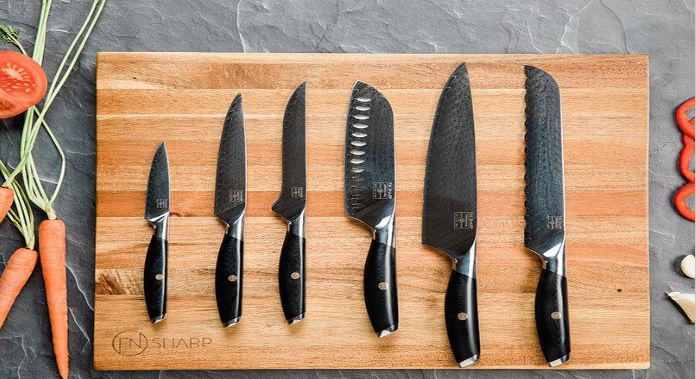In the vast world of culinary arts, having the right tools is essential. When it comes to kitchen knives, there is a wide variety available, each designed for specific tasks. Let’s explore some of the most common types of kitchen knives and their purposes:
- Chef’s Knife: The chef’s knife is a versatile, all-purpose knife with a broad blade and a slight curve. It’s ideal for chopping, slicing, and dicing various ingredients, making it a must-have for any cook.
- Santoku Knife: Originating from Japan, the santoku knife features a shorter, wider blade with a flat cutting edge. It excels at precision tasks like slicing, dicing, and mincing. The Granton edge, with its small air pockets along the blade, helps prevent food from sticking.
- Paring Knife: The paring knife is a small, nimble knife with a pointed tip. It is perfect for intricate tasks like peeling, trimming, and slicing small fruits and vegetables. Its compact size allows for precise control and manoeuvrability.
- Bread Knife: The bread knife has a long, serrated blade that effortlessly cuts through crusty bread without crushing it. The serrations grip the bread’s surface, ensuring clean slices without tearing or crumbling.
- Utility Knife: A utility knife is a smaller version of a chef’s knife, featuring a narrower and more flexible blade. It’s designed for tasks that require more precision, such as cutting small fruits, vegetables, or sandwiches.
- Boning Knife: The boning knife has a thin, narrow, and flexible blade used for separating meat from bones. It is invaluable for butchering, deboning poultry or fish, and trimming fat.
- Cleaver: The cleaver is a heavy, rectangular knife with a thick spine. It is primarily used for splitting large cuts of meat, but its weight and sturdy blade make it useful for other tasks like crushing garlic or chopping through bones.
- Slicing Knife: A slicing knife has a long, narrow, and sharp blade, specifically designed for slicing cooked meats, roasts, and poultry. Its thin edge ensures thin, even slices without tearing or shredding the meat.
- Fillet Knife: The fillet knife features a long, flexible blade that tapers to a pointed tip. It is specifically designed for filleting fish, effortlessly gliding along the bones to remove the skin and create precise fillets.
These are just a few examples of the many kitchen knife types available. Each knife serves a specific purpose, enhancing your efficiency and precision in the kitchen. Investing in a quality set of essential knives can greatly elevate your cooking experience and skill.
Remember to choose knives that suit your cooking style, preferences, and the tasks you frequently undertake. With the right tools at your disposal, you can conquer any culinary challenge with ease and confidence.
Reach out for any knife advice. MBS

